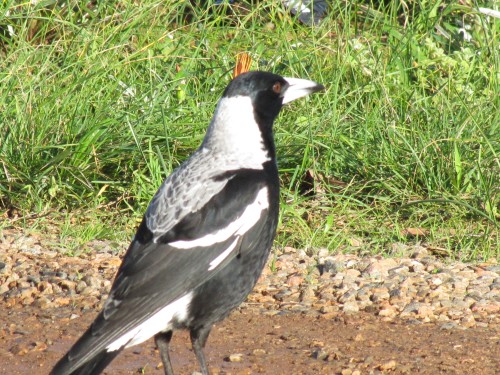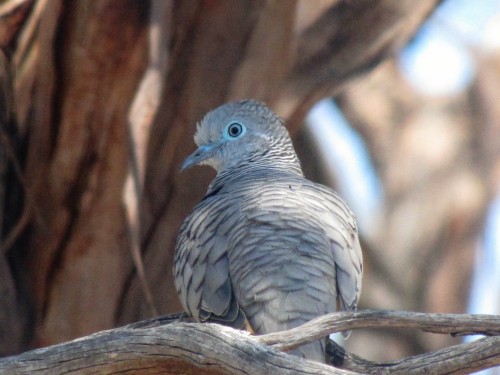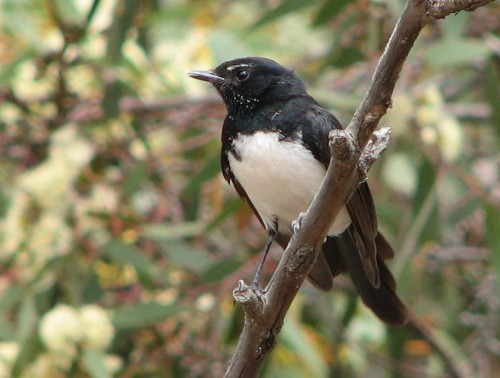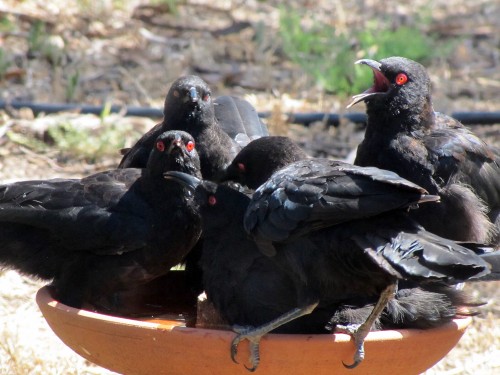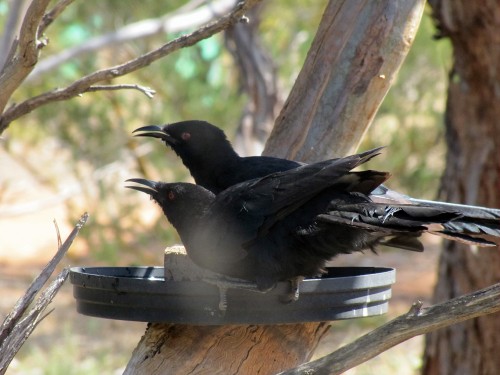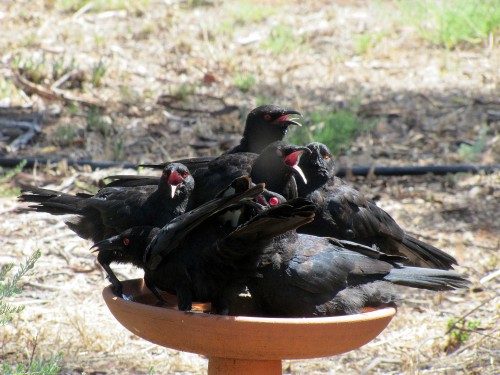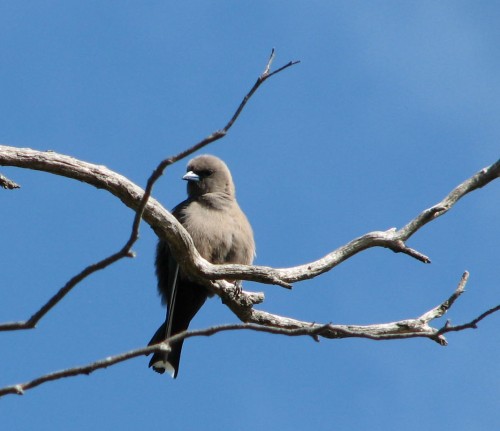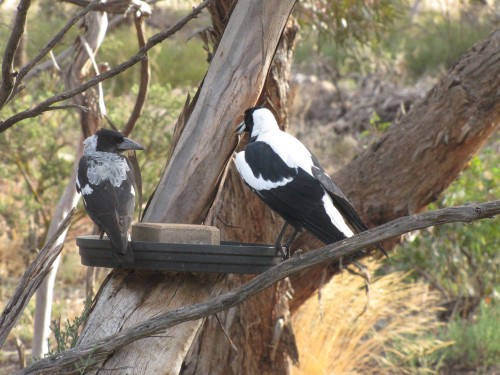Happy Christmas
HAPPY CHRISTMAS to all of my readers.
I watched the news this evening and saw that terrible weather conditions are being experienced by many people around the world. From storms, heavy rain, blizzards, to deep snow and heat waves. Our own South Australian capital city, Adelaide, had the highest temperature of all the cities of the world: 41.3C (106F). I live only 80km south east of Adelaide and it was very hot here too – around the same temperature; it may have just touched 42 for a while. Except for a trip to church early in morning, I stayed indoors in air-conditioned comfort. Thankfully, cooler weather and rain is forecast for later in the week.
Birds in hot weather
Yesterday I wrote about the importance of regularly providing fresh water for the birds in your garden, especially in the type of hot weather we experience in summer here in Australia. They really appreciate it, and this provides opportunities for the avid birder to watch them through a nearby window without disturbing them in any way.
Because of the hot weather, I was reluctant to get out and about. Despite the heat, I was aware of some of the species outside. Some of our birds have loud calls, and we had a very quiet Christmas with no visitors. Several times I heard Peaceful Doves calling, and there was the persistent call of a baby Red Wattlebird just out of the nest. Through one of our windows I saw our resident Willie Wagtails a few times, and this evening, when I briefly braved the elements, I disturbed a small flock of Galahs from one of our trees.
The resident Australian Magpies came frequently for a drink at the bird bath, and earlier this morning I observed a loose flock of about 25 Little Ravens flying overhead. The resident House Sparrows kept in the shade for most of the day, coming to the water in the birdbaths frequently. We usually hear the noisy and gregarious New Holland Honeyeaters, but they were rather subdued today. So were the Spiny-cheeked Honeyeaters and the White-plumed Honeyeaters. I also briefly heard the small family of Superb Fairy-wrens which occupy the bushy parts of our property.
I just checked the weather radar; there are storms on the way. Tomorrow I must get outside a few times and keep a look out for Swifts; just their kind of conditions.
Once the weather cools a little, I hope to get out and about a few times. It is about time I took some more photos to share here.
In the meantime, I hope that you have a wonderful Christmas wherever you are, and whatever the weather.
Good birding,
Trevor
Make room for me
We have many different species come to visit our bird baths. They come either for a drink or for a bath – sometimes both. Many of these species are quite small, such as the thornbills and pardalotes. At the other end of the scale where size is considered would have to be the Little Ravens, Grey Currawongs and of course, the White-winged Choughs, featured in today’s photos.
This series of photos was taken during our recent heat wave in South Australia. Our capital city Adelaide saw a 117 year record broken: 13 days over 40C over the summer, previously 11 days. Here in Murray Bridge we certainly have more than that. During hot weather the birds flock to the water throughout the day. Refilling the baths is a daily task.
The White-winged Choughs all seem to crowd onto the one bird bath, each wanting a piece of the action. It is quite comical to witness the jostling and arguing over the prime positions. Sensible birds take up a position on one of the other bird baths nearby.
Early morning birding walk
I went for an early morning walk today. It was an enforced walk: I had just taken our car to local garage for a regular service and check up. I could have asked my wife to pick me up in her car but she was still in bed. Despite the early hour, the air was already quite warm and I could understand why most of South Australia has had fire bans issued for the day. Our first burst of hot weather for the summer promises to be a good one. Time to hunker down and do some indoor things. Like reading. Or writing this post.
On my morning walk I was aware of the vast amount of activity on the part of the birds. My walk took exactly 28 minutes to complete and I saw or heard most of the locally resident species along the way, including large numbers of Galahs. The highlight of the walk was two Dusky Woodswallows perched on the fence of a nearby neighbour’s property.
While this species is a regular visitor to our little piece of Australia (5 acres), I can’t call it a resident species. This “pair” of birds – I use the term cautiously – have been sighted on a few occasions in the same spot over the last few weeks. I suspect that they are actually a pair and have a nest nearby. Quite a few years ago a pair nested in one of the trees in our front scrub near our house.
Of course, I didn’t have my camera with me this morning, and my phone camera doesn’t have a zoom sufficient for the job, so I have posted below a photo taken some time ago. This was taken in our scrub near the house.
Australian Magpies at the bird bath
We have quite a few resident Australian Magpies in our garden and on our five acre property. Every year we watch out for nest building time to see which tree they will use; sometimes they refurbish an old nest.
In the hot weather anything up to 6 or 7 of them gather under the shade of our back veranda, often crouching under the easy chairs we have there for extra coolness. The sun in the open on hot days can be as high as 50C or more, while under the veranda it can be 10 degrees cooler – which is still very hot!
Our bird baths are also very popular with all species. Most smaller birds tend to fly off when the magpies occupy the cooling water.
In the photos shown today, the bird on the left is a juvenile, possibly a female. The one on the right is a mature male.
Australian Magpies on a hot day
As I write this article the temperature has just topped 43C (109F) under our back veranda. I haven’t seen or heard many birds all morning which is understandable. As we were having lunch we watched three of our resident Australian Magpies sitting in the bird baths. They came to sit in the water and occasionally have a sip of water.
Before lunch I filled a bucket of fresh rainwater to top up three of the bird baths we have in our garden. The magpies shown in these photos moved only about a metre away while I tipped in the water. They obviously were too hot to move further away. As soon as I left they were back in the water again and have stayed there for the last few hours. Can’t say I blame them. It’s mighty hot out there.
During lunch the only other birds to come for a drink were a solitary Crested Pigeon and one Australian Magpie Lark. I’m not sure where all the other birds are holed up against the oppressive conditions. Usually there is a steady procession of honeyeaters (at least 5 species), thornbills (2 species), pardalotes (2 species), sparrows, parrots (3 species) and doves.
For a complete list of species that have visited our bird baths, click here.
